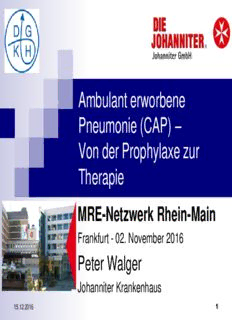
Ambulant erworbene Pneumonie (CAP) PDF
Preview Ambulant erworbene Pneumonie (CAP)
Ambulant erworbene Pneumonie (CAP) – Von der Prophylaxe zur Therapie MRE-Netzwerk Rhein-Main Frankfurt - 02. November 2016 Peter Walger Johanniter Krankenhaus 15.12.2016 1 AWMF Reg.-Nr. 082 - 001 15.12.2016 2 Worüber reden wir ? CAP ist nicht: Nosokomiale Pneumonie (klar!), > 48h nach Aufnahme Pneumonie bei Immunsuppression (egal ob ambulant oder nosokomial erworben) Pneumonie bei COPD (Infekt-exacerbiert) CAP kann vorliegen Bei Heimbewohneren (bettlägerig oder nicht) Bei Aspiration (oder ohne) Bei Komorbidität (außer COPD) 15.12.2016 3 Pneumonie-Triade Pneumonie Ort des Erwerbs Immunstatus Ambulant erworben (community- außerhalb des immunkompetent acquired pneumonia, ambulant Krankenhauses erworbene Pneumonie, CAP) im Krankenhaus Nosokomial erworben (hospital- (> 48 h nach immunkompetent acquired pneumonia, HAP) Krankenhausaufnahme) Unter Immunsuppression außerhalb des Schwere (pneumonia in the Krankenhauses oder im Immunsuppression immunosuppressed host) Krankenhaus erworben S3-LL CAP, AWMF Reg.-Nr. 082-001, S. Ewig et al. 2016 Behandlung von erwachsenen Patienten mit ambulant erworbener Pneumonie und Prävention – Update 2016 15.12.2016 4 Diagnose der CAP Respiratorische Symptome Fieber – Husten – Auswurf – Dyspnoe – Tachypnoe - Schmerzen (atemabhängig) – „grippale“ Allgemeinsymptome – Verwirrtheit – Hypotonie - Eitriges Sputum Pathologischer Auskultationsbefund Nachweis von Infiltraten im Rö-Thorax in 2 E (pulmonale Sonografie, CT-Thorax) Schweregrad Bestimmung CRB-65 CRB-65- Patientenmerkmal Risikoklasse 1: Punktwert 0 Risikopunkte Mental Confusion 1 Neu aufgetretene Pneumonie- assoziierte Desorientierung Risikoklasse 2: 1 - 2 Risikopunkte Respiratory Rate 1 Spontane Atemfrequenz ≥ 30 Atemzüge/min Risikoklasse 3: Blood Pressure 1 3 - 4 Risikopunkte Blutdruck systolisch < 90 mm Hg oder oder diastolisch ≤ 60 mm Hg Beatmung Alter ≥ 65 Jahre 1 bei Aufnahme nein oder ja S3-LL CAP, AWMF Reg.-Nr. 082-001, S. Ewig et al. 2016 Behandlung von erwachsenen Patienten mit ambulant erworbener Pneumonie und Prävention – Update 2016 15.12.2016 6 2008-2010: 660.594 Patienten; Letalität n = 93.958 (14.0 %) Pflegeheim ja/nein Bettlägerigkeit ja/nein 15.12.2016 7 7% 6% 5% e ta CRB-65=0 r d 4% CRB-65=1 r a z CRB-65=2 a h h 3% CRB-65=3 t a CRB-65=4 e d 2% 1% 0% 0 3 6 9 12 15 18 21 24 27 30 33 36 39 42 45 48 51 54 57 day after hospitalization 15.12.2016 8 Ambulant erworbene Pneumonie Erregerspektrum: die drei führenden Erreger Streptococcus pneumoniae 1. Streptococcus pneumoniae 2. Streptococcus pneumoniae 3. . . . Alle Sonstigen 15.12.2016 9 Keine ätiologische Relevanz als Pneumonie-Erreger Corynebacterium spp. Enterococcus spp. Neisseria spp. α-hämolysierende (vergrünende) Streptokokken Koagulase-Negative Staphylokokken Candida spp. 15.12.2016 10
Description: